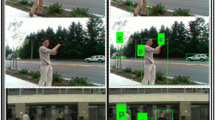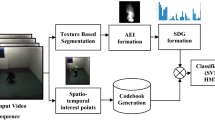Abstract
Automated detection and tracking of a person’s actions plays a vital role in surveillance systems. Human activity detection has been carried out by using a variety of features; including flow-based, spatio-temporal and interest points based. We have created a fusion of features by incorporating those which give better results. LBP, HOG, Haar wavelets, SIFT, velocity and displacement being the major ones. By employing the time efficiency and optimality of SMO to train SVM, we have trained our system for both single person and multi-human action classification with improved accuracy. A generalized hierarchy of actions has been presented in this paper to demonstrate the extension of our methodology. We have achieved an accuracy of 91.99% on combination of KTH and Weizmann dataset and 86.48% on multi-human dataset. We have introduced our self-generated multi-human activity dataset in the following paper.








Similar content being viewed by others
Explore related subjects
Discover the latest articles, news and stories from top researchers in related subjects.References
Moussa MM et al (2015) An enhanced method for human action recognition. J Adv Res 6(2):163–169
Kolekar MH, Dash DP (2016) Hidden markov model based human activity recognition using shape and optical flow based features. In: Region 10 conference (TENCON) (2016 IEEE) IEEE
Yang J, Cheng J, Lu H, Human activity recognition based on the blob features. In: IEEE international conference on multimedia and expo, pp 358361, 2009
Niebles JC, Fei-Fei L (2007) A hierarchical model of shape and appearance for human action classification. In: IEEE conference on computer vision and pattern recognition, 2007. CVPR’07. IEEE
Ke S-R et al (2013) A review on video-based human activity recognition. Computers 2(2):88–131
Li W, Zhang Z, Liu Z (2010) Action recognition based on a bag of 3d points. In: 2010 IEEE computer society conference on computer vision and pattern recognition workshops (CVPRW). IEEE
Li W, Zhang Z, Liu Z (2008) Expandable data-driven graphical modeling of human actions based on salient postures. IEEE Trans Circ Syst Video Technol 18(11):1499–1510
Wang H et al (2013) Dense trajectories and motion boundary descriptors for action recognition. Int J Comput Vis 103(1):60–79
Kellokumpu V, Pietik ainen M, Heikkila J (2005) Human activity recognition using sequences of postures. MVA, pp 570–573
Wang H, Schmid C (2013) Action recognition with improved trajectories. In: Proceedings of the IEEE international conference on computer vision
Schuldt C, Laptev I, Caputo B (2004) Recognizing human actions: a local SVM approach. In Proceedings of the 17th IEEE international conference on pattern recognition (ICPR), Cambridge, UK, 2326 August 2004; vol 3, pp 32–36
Vapnik V (1999) The nature of statistical learning theory. Springer, New York
Hoang LUT, Ke S, Hwang J, Tuan PV, Chau TN (2012) Quasi-periodic action recognition from monocular videos via 3D human models and cyclic HMMs. In: Proceedings of IEEE international conference on advanced technologies for communications (ATC), Hanoi, Vietnam, 1012 October 2012; pp 110–113
Yamato J, Ohya J, Ishii K ( 1992) Recognizing human action intime- sequential images using hidden markov model. In: IEEE computer society conference on computer vision and pattern recognition, pp 379–385
Brand M, Oliver N, Pentland A (1997) Coupled hidden markov models for complex action recognition. In: Proceedings of IEEE computer society conference on computer vision and pattern recognition (CVPR), San Juan, PR, USA, 1719 June 1997; pp 994–999
Duong TV, Bui HH, Phung DQ, Venkatesh S (2005) Activity recognition and abnormality detection with the switching hidden semi-markov model. In: Proceedings of the IEEE computer society conference on computer vision and pattern recognition (CVPR), San Diego, CA, USA (2005) June 2005; vol 1, pp 838–845
Fiaz MK, Ijaz B (2010) Vision based human activity tracking using artificial neural networks. In: Proceedings of IEEE international conference on intelligent and advanced systems (ICIAS), Kuala Lumpur, Malaysia, 1517 June 2010; pp 15
Umakanthan S, Denman S, Fookes C, Sridharan S (2014) Activity recognition using binary tree SVM. In: IEEE workshop on statistical signal processing, pp 248–251
Platt J (1998) Sequential minimal optimization: a fast algorithm for training support vector machines. Technical Report MSR-TR-98-14, Microsoft Research
Kolekar MH, Sengupta S (2004) Hidden markov model based structuring of cricket video sequences using motion and color features. In: Indian conference on computer vision graphics and image processing, pp 632–637
Thurau C, Hlavc V (2008) Pose primitive based human action recognition in videos or still images. In: IEEE conference on computer vision and pattern recognition, 2008. CVPR 2008. IEEE
Chen M, Hauptmann A (2009) MoSIFT: recognizing human actions in surveillance videos. In: CMU-CS-09-161, Carnegie Mellon University
Chathuramali KG, Manosha, Rodrigo R (2012) Faster human activity recognition with SVM. In: 2012 international conference on advances in ICT for emerging regions (ICTer). IEEE
Chathuramali KM, Rodrigo R (2012) Faster human activity recognition with SVM. In: International conference on advances in ICT for emerging regions, pp 197–203
Liu L, Wang S, Su G, Huang ZG, Liu M (2017) Towards complex activity recognition using a Bayesian network-based probabilistic generative framework. Pattern Recogn 68:295–309
Brendel W, Fern A, Todorovic S. Probabilistic event logic for interval-based event recognition. In: 2011 IEEE conference on computer vision and pattern recognition (CVPR) 2011 Jun 20, pp 3329–3336. IEEE
Abdul-Azim HA, Hemayed EE (2015) Human action recognition using trajectory-based representation. Egypt Inform J 16:187198
Chaquet JM, Enrique J, Carmona, Fernndez-Caballero A (2013) A survey of video datasets for human action and activity recognition. Comput Vis Image Underst 117(6):633–659
Gilbert A, Illingworth J, Bowden R (2008) Scale invariant action recognition using compound features mined from dense spatio-temporal corners. In: European conference on computer vision. Springer, Berlin
Uemura H, Ishikawa S, Mikolajczyk K. Feature tracking and motion compensation for action recognition. In: Proc. of BMVA british machine vision conference
Schuldt C, Laptev I, Caputo B (2004) Recognizing human actions: a local SVM approach. In: proceedings of the 17th international conference on pattern recognition, 2004. ICPR 2004, vol 3. IEEE
Gilbert A, Illingworth J, Bowden R (2009) Fast realistic multi-action recognition using mined dense spatio-temporal features. In: 2009 IEEE 12th international conference on computer vision. IEEE
Gorelick L et al (2007) Actions as space-time shapes. IEEE Trans Pattern Anal Mach Intell 29(12):2247–2253
Uddin Md, Zia et al (2013) An indoor human activity recognition system for smart home using local binary pattern features with hidden markov models. Indoor Built Environ 22(1):289–298
Mattivi R, Shao L (2009) Human action recognition using LBP-TOP as sparse spatio-temporal feature descriptor. In: International conference on computer analysis of images and patterns. Springer, Berlin
Kellokumpu V, Zhao G, Pietikinen M (2011) Recognition of human actions using texture descriptors. Mach Vis Appl 22(5):767–780
Bruzzone L, Persello C (2009) A novel approach to the selection of spatially invariant features for the classification of hyperspectral images with improved generalization capability. IEEE Trans Geosci Remote Sens 47(9):3180–3191
Joachims T. Training linear SVMs in linear time. In: Proceedings of the 12th ACM SIGKDD international conference on knowledge discovery and data mining. ACM, 2006
Blank M et al (2005) Actions as space-time shapes. In: Tenth IEEE international conference on computer vision, ICCV 2005, vol 2. IEEE, 2005
Schindler K, Van Gool L (2008) Action snippets: how many frames does human action recognition require?. In: IEEE conference on computer vision and pattern recognition, 2008. CVPR 2008. IEEE
Jhuang H et al (2007) A biologically inspired system for action recognition. In: IEEE 11th international conference on computer vision, ICCV 2007. IEEE, 2007
Fathi A, Mori G (2008) Action recognition by learning mid-level motion features. In: IEEE conference on computer vision and pattern recognition, 2008. CVPR 2008. IEEE
Klaser A, Marszaek M, Schmid C (2008) A spatio-temporal descriptor based on 3D-gradients. In: BMVC
Laptev I, Marszalek M, Schmid C, Rozenfeld B (2008) Learning realistic human actions from movies. In: IEEE CVPR
Abdul-Azim HA, Hemayed EE (2015) Human action recognitionusing trajectory-based representation. Egypt Inform J 16:187198
Ji S, Xu W, Yang M, Yu K (2013) 3D convolutional neural networks for human action recognition. IEEE Trans Pattern Anal Mach Intell 35(1):221–231
Raja K, Laptev I, Perez P, Oisel L (2011) Joint pose estimation and action recognition in image graphs. In: International conference on image processing, Brussels, Belgium, Sept. 2011, pp 2528
Author information
Authors and Affiliations
Corresponding authors
Additional information
Publisher’s Note
Springer Nature remains neutral with regard to jurisdictional claims in published maps and institutional affiliations.
Rights and permissions
About this article
Cite this article
Naveed, H., Khan, G., Khan, A.U. et al. Human activity recognition using mixture of heterogeneous features and sequential minimal optimization. Int. J. Mach. Learn. & Cyber. 10, 2329–2340 (2019). https://doi.org/10.1007/s13042-018-0870-1
Received:
Accepted:
Published:
Issue Date:
DOI: https://doi.org/10.1007/s13042-018-0870-1




